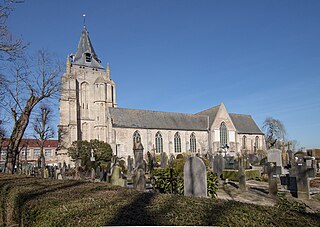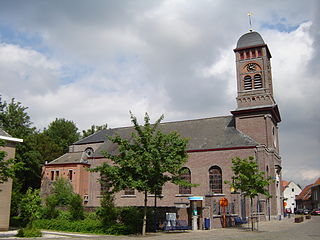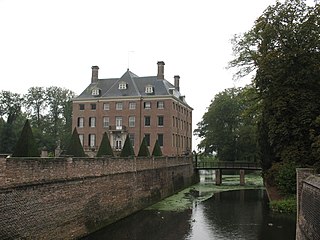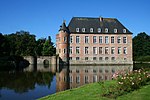
West Flanders is the westernmost province of the Flemish Region, in Belgium. It is the only coastal Belgian province, facing the North Sea to the northwest. It has land borders with the Dutch province of Zeeland to the northeast, the Flemish province of East Flanders to the east, the Walloon province of Hainaut in the south and the French department of Nord to the west. Its capital is Bruges (Brugge). Other important cities are Kortrijk in the south and Ostend (Oostende) on the coast, Roeselare and Ypres (Ieper). The province has an area of 3,197 km2 (1,234 sq mi) which is divided into eight administrative districts (arrondissementen) containing 64 municipalities. As of January 2024, West Flanders has a population of over 1.22 million.

Veurne is a city and municipality in the Belgian province of West Flanders. The municipality comprises the town of Veurne proper and the settlements of Avekapelle, Booitshoeke, Bulskamp, De Moeren (Belgium), Eggewaartskapelle, Houtem, Steenkerke, Vinkem, Wulveringem, and Zoutenaaie.

Ooidonk Castle is a castle in the city of Deinze, East Flanders, Belgium. The castle is the residence of the current Count t'Kint de Roodenbeke. Ooidonk Castle is situated at an altitude of 11 meters.
On the territory of the municipality of Westerlo there are several castles.

Loppem Castle is a mansion situated in Loppem in the municipality of Zedelgem, near Bruges in West Flanders, in the Flemish Region of Belgium.

Houtem is a village in the municipality of Veurne in the Belgian province of West Flanders. The village is located near the French border. Until 1977, Houtem was an independent municipality. During World War I, it was home to the Headquarters of the Belgian Army.

Vogelsanck Castle is a moated castle in Zolder in the municipality of Heusden-Zolder, province of Limburg, Belgium.

Bornem Castle, also known as the Marnix de Sainte-Aldegonde Castle, is a country house, formerly a castle, located in Bornem, province of Antwerp, Belgium. Bornem Castle is situated at an elevation of 1 meters.

Vinderhoute is a village in the municipality of Lievegem in the province of East Flanders in Belgium. It is located in the Flemish Valley about 6 kilometres (3.7 mi) north-west of Ghent.

Amerongen Castle is a castle in Amerongen, Utrechtse Heuvelrug, Netherlands. It was built between 1674 and 1680, on the site of a medieval castle that had been burned down by the French in 1673. The gardens still contain historic elements such as a conservatory dating from the 1890s. In 1918, the former German Kaiser Wilhelm II signed his abdication here and stayed till 1920, when he moved to Huis Doorn.

Beschermd erfgoed is the official term to describe Flemish National Heritage Sites listed by law to protect and spread awareness of Belgian cultural heritage, specifically in Flanders. The term is also used nationwide to refer to national heritage sites. Because Belgium is officially a tri-lingual country, the other nationwide terms used in the rest of the country are the French term Bien classé and the German term Kulturdenkmal.

Fort Napoleon in Ostend is a polygonal fort built in the Napoleonic era. It has recently been restored and is open to the public.

Rutten is a village in the Tongeren municipality of the Limburg province in the Flemish Community of Belgium. The village is located in the Haspengouw region, and was a separate municipality until its merger into Tongeren in 1977.

Viane is a village in the Geraardsbergen municipality of the East Flanders province in the Flemish Community of Belgium. The village is situated in the Denderstreek in the south east of the province, on the border with Flemish Brabant and Hainaut. The river Mark separates the village from the rest of Geraardsbergen.

Mesen Castle was an important noble residence in Lede, Belgium, today partly ruined and completely abandoned. The castle is considered to have been one of the most important aristocratic estates of the 18th century.
Raymond Pelgrims de Bigard was a Belgian industrialist, famous for the conservation and restoration of historic castles.

Prinsenkasteel was a castle located in Grimbergen, Belgium. It was the residence of the lords of Grimbergen from the 14th Century onwards. The castle ruins are located in Prinsenbos Park.

Ocket Castle is a house, on the site of a castle, in Heusden, Destelbergen, East Flanders, Belgium. It probably originated on the former fief of Grooten Hoek that lasted until the 15th century. The castle was depicted on a 1725 map by PJ Benthuys as a building with a moat near the Scheldt and is mentioned in 1767 as a "partije genaemt den grieten hoeck met de mote ende huys van playsance". The present Neoclassical building dates largely from the 18th and 19th centuries but contains a dining room on the east side that in the 17th/18th century was the core of the structure, as was established among other things from the beams and the Rococo stucco decorations.

Bueren Castle is a 16th-century moated castle in Melle-Kwatrecht. The castle domain is 10 hectares and is located in two municipalities.

Breivelde Castle and the surrounding park Breivelde estate is a castle in Grotenberge, Zottegem in Belgium. Breivelde castle was built in Renaissance Revival architecture in 1904 by owner Philippe Plancqaert van Exen van Beauvechain, replacing a mansion erected in 1871 by former owner August De Rouck. It is surrounded by a public English landscape garden containing ponds, cascades and exotic trees. The imitation river bend mirrors the castle in its waters. Since 1971 the domain is open to the public. The castle underwent several restorations; a new restoration phase started after 2021. It is a heritage monument landscape since 1982.






















